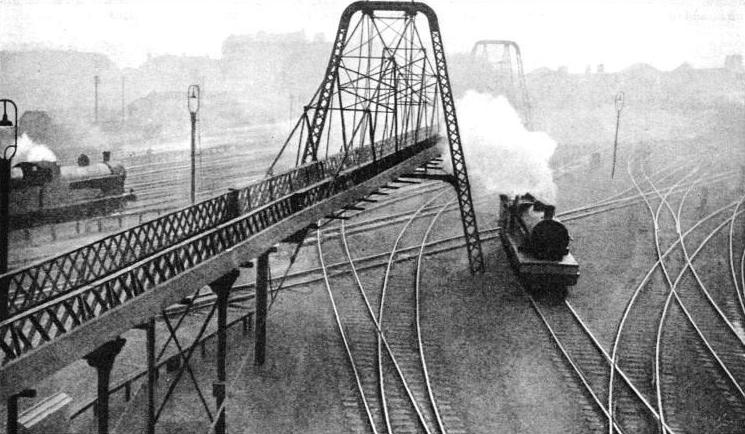
© Railway Wonders of the World 2012-


The Story of the L.M.S.
Nation-
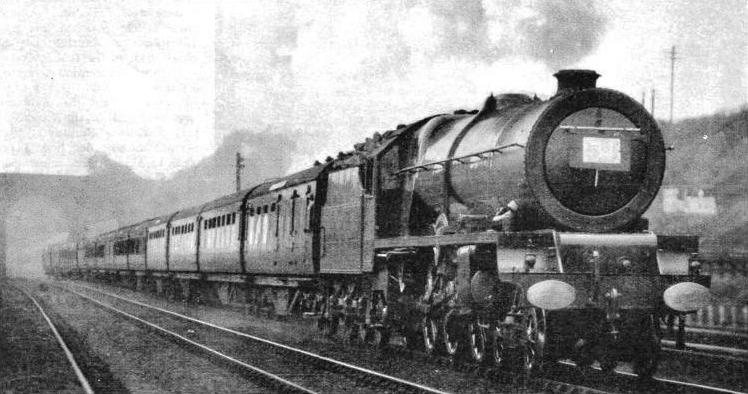
ON THE MAIN LINE of the LMS Western Section, formerly London and North Western Railway. The express illustrated is the down “Royal Scot”, near Bushey, Herts, sixteen miles from Euston. At the head of the train is the “Pacific” locomotive 6201, “Princess Elizabeth”.
OF the four great railways formed in 1923 by the Railways Act of 1921, the London, Midland and Scottish is the largest. It is the only British railway serving England, Scotland, Wales and Ireland. Excluding the Irish Northern Counties Committee and certain joint lines, its route mileage is 6,758, and its total length, reduced to single track, is 18,921 miles.
The LMS is made up of seven constituent and twenty-
Of the constituent companies the London and North Western, generally accorded the title of “the premier line”, was the largest, with a route mileage of 1,807 in 1921. Next in order of length were the Midland, with 1,529, and the Caledonian, with 896 route miles. The corresponding figures for the other constituent companies were Highland 485, Glasgow and South Western 449, North Staffordshire 206, and Furness 115. The route mileage of the Lancashire and Yorkshire Railway in 1920 was 533.
The subsidiary companies included the Wirral, serving the Cheshire peninsula of that name; the Stratford-
At the present day the LMS is divided into the Western Division (including most of the former London and North Western Railway), the Midland Division (former Midland Railway), the Central Division (Lancashire and Yorkshire), and the Northern Division (including all the three Scottish lines taken over in 1923).
Some idea of the extent of the LMS system may be gathered from the fact that its main lines extend from London to Wick, in the far north of Scotland and 729 miles from Euston. Even this is not the extreme limit of the LMS, as a branch line runs from Wick to Lybster, 742½ miles from Euston. The most northerly railway station in Great Britain is Thurso, on an LMS branch of the main line to Wick. diverging at Georgemas.
The main line of the former London and North Western Railway runs from Euston to Carlisle, 299 miles distant, by what is known as the West Coast Route. Its main intermediate stations are Rugby, Stafford, Crewe, and Preston. The most important of its numerous branches are those from Rugby to Birmingham (originally a continuation of the main London and Birmingham line); from Crewe to Manchester, to Chester and Holyhead (for steamers to Ireland), and to Shrewsbury (for the joint line referred to later); and from Sutton Weaver Junction, about sixteen miles north of Crewe, to Liverpool.
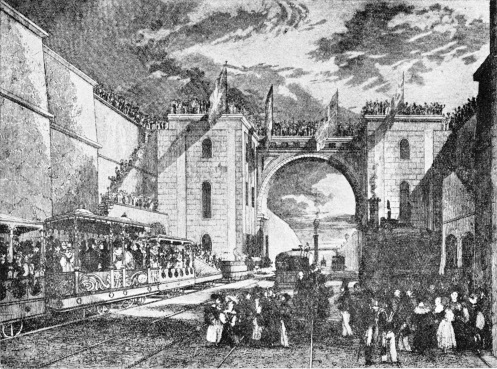
OPENING OF THE RAILWAY. The Liverpool and Manchester Railway, thirty one and a half miles long, and the nucleus of the LMS, was opened on September 15, 1830. The print shows the arch at Edge Hill, one and a half miles east of Liverpool.
The country of the former North Staffordshire Railway lies to the east of a line drawn from Stafford to Crewe. The North Staffordshire line from Colwich, a junction on the main West Coast Route six miles east of Stafford, provides the shortest route (183½ miles) between London and Manchester, though the fastest Euston-
From Carnforth, twenty-
The former Midland main line from St. Pancras to Carlisle, 310½ miles in length, runs via Leicester, Sheffield, Leeds (for Bradford), and Hellifield. A loop-
At Carlisle Station the main line of the Midland Division meets that of the former London and North Western. Running across the two main routes is a maze of lines uniting Lancashire and Yorkshire. One of these is the shortest line from Liverpool to Manchester -
From Carlisle the main line -
The Highland line, uses Perth as its starting-
It is not possible here to do justice to the numerous minor branches of the LMS. One of these, however, calls for mention by reason of its length -

A FIRST-
In conjunction with the Great Western Railway the LMS operates the busy cross-
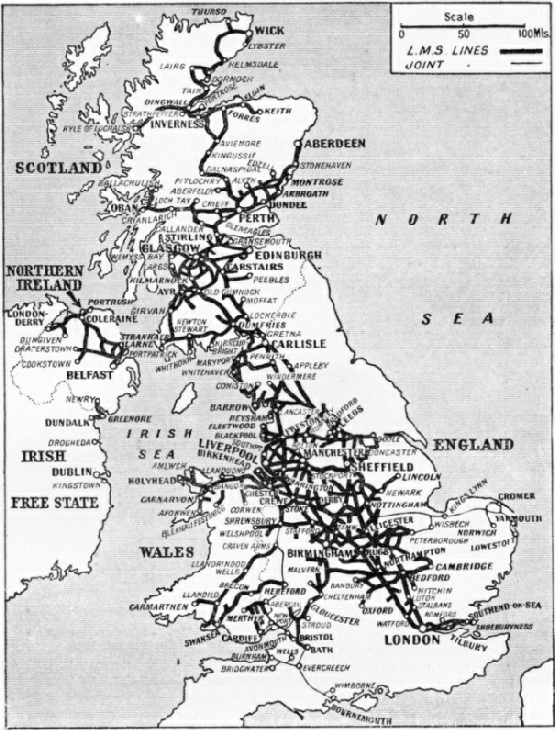 In Ireland the LMS owns and works the Northern Counties Committee (formerly the Belfast and Northern Counties Railway), whose main line is from Belfast to Londonderry. The LMS also owns the Dundalk, Newry and Greenore Railway, worked by the Irish Great Northern Railway; and it is jointly interested with the latter company in the narrow-
In Ireland the LMS owns and works the Northern Counties Committee (formerly the Belfast and Northern Counties Railway), whose main line is from Belfast to Londonderry. The LMS also owns the Dundalk, Newry and Greenore Railway, worked by the Irish Great Northern Railway; and it is jointly interested with the latter company in the narrow-
THE EXTENT of the LMS system is indicated on this map, which shows the lines in England, Wales, Scotland, and Ireland.
In view of the wide ramifications of the LMS system it is not surprising that its route mileage exceeds that of any of the other great British railways. Indeed the mileage compares favourably with that of the great overseas railways. Although, for example, the Canadian Pacific Railway extends across the North American Continent, its track mileage is not proportionately in excess of that of the LMS.
But it is not in length alone that the LMS can claim distinction. It possesses the largest stock of locomotives, carriages and wagons. On January 1, 1934 it owned 8,004 locomotives, 24,023 coaching vehicles, 250 electric-
In addition, the company owns 2,088 parcels and goods road motor vehicles, and over 8,400 horses. It possesses also forty-

“ROCKET” WINS. The historic trial of locomotives at Rainhill, nine miles east of Liverpool, was begun on October 6, 1829. Five engines competed -
Of British railways, the LMS handles the largest passenger and goods traffic, and earns the largest income, its weekly traffic receipts averaging over £1,000,000. It owns numerous hotels, including some of the finest in the country.
The passenger train services are generally fast and frequent. The company has the largest number of long non-
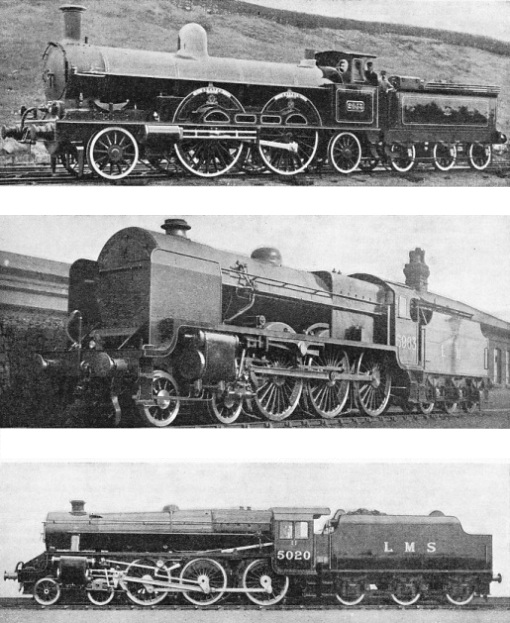 “GREATER BRITAIN”, a Webb three-
“GREATER BRITAIN”, a Webb three-
ONE OF THE “BABY SCOTS”. These 4-
FOR MIXED TRAFFIC. A 4-

THE LOUVRED CHIMNEY of this locomotive -
HALF A CENTURY of locomotive development is illustrated in this picture. On the left is No. 14010, the last remaining single-
ARTICULATED BEYER-
The number of trains booked at fifty-
As stated in the chapter Speed Trains of Britain, which begins on page 695, the fastest LMS train is the 5.25 pm from Liverpool to Euston, which covers the 152.7 miles from Crewe to Willesden Junction in 142 minutes, at an average speed of 64.5 miles an hour. At the time of writing its schedule is the second fastest in the British Isles, being beaten only by that of the “Cheltenham Flyer”, between Swindon and Paddington.
The locomotives are up to date and efficient, large numbers of passenger and freight engines having been built in recent years. The LMS is the only British railway which employs compound locomotives in large numbers. The largest LMS locomotives are not, however, compounds. Experiments are constantly being made with new types, including turbine locomotives, and rail-
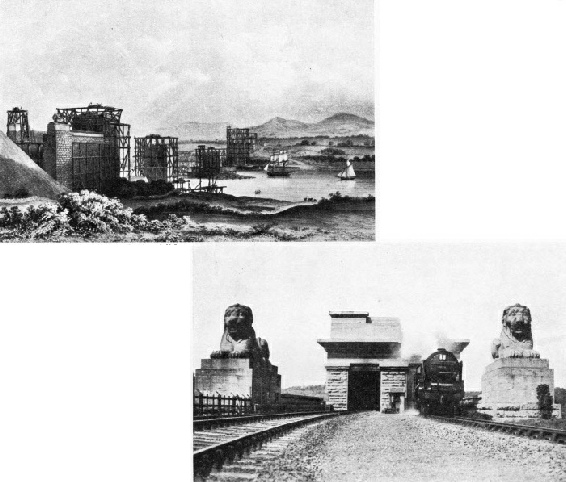
THE BRITANNIA TUBULAR BRIDGE across the Menai Straits was built by Robert Stephenson, in 1846-
THE EAST END OF THE BRITANNIA TUBULAR BRIDGE at the present day, with No. 6146, “Jenny Lind”, a 4-
Although it is the proud and well founded boast of the LNER that, by virtue of ownership of the Stockton and Darlington Railway, it is “the oldest firm in the railway business”, the beginnings of the London, Midland and Scottish system go back nearly a quarter of a century before that September day in 1825 when the first public railway was opened.
The Sirhowy branch of the London and North Western, in North Wales, was originally a plate way -
These early lines were more numerous than is generally realised, since no fewer than twenty-
Included in the LMS is the Liverpool and Manchester, the second public railway in the world. Within five years of the opening of the line passenger receipts amounted to ten time the promoters’ estimates, and goods earnings to three times as much as had been reckoned on. Through its ownership of this line, the LMS claims to be “the oldest-
The real history of the LMS thus begins with the Liverpool and Manchester, which was incorporated in 1826. But this was a year later than the Cromford and High Peak Railway, which was absorbed by the London and North Western in 1887, and, despite its short length, is unusually interesting from both the historical and engineering standpoints. It was built to connect the Midland Counties with Liverpool and Manchester, the mountainous nature of the district making a canal out of the question, and it joined the Cromford Canal with the Peak Forest Canal at Whaley Bridge. The line is in part as much as a thousand feet above sea level, this elevation being made possible by the use of a number of inclined planes with gradients as steep as 1 in 7½ and 1 in 8½, on which traffic was originally worked by fixed engines. On the intervening sections, horses at first were used. The line, which was opened in 1830, was thirty-

EVOLVED FROM THE STAGE COACH. “Experience”, an early first-
A FIRST-
But to return to the Liverpool and Manchester -
Parliament was told that the Moss was too formidable an obstacle to be crossed, while another sceptic said that if it were possible the cost would be well over a quarter of a million. The expense proved to be only £28,000, and the method adopted was to spread hurdles interwoven with heather so as to form a floating road, and to construct a watercourse (drainage being impracticable) out of empty tar barrels covered with clay. On this foundation the weight of track and trains was not only safely supported, but also the section “eventually proved to be the most satisfactory part of the line”, although its abandonment had at one time seriously been considered because of the difficulties involved. The Olive Mount Cutting, which has been illustrated in so many of the early railway prints, is two miles long and more than a hundred feet deep in parts, and involved the removal of nearly half a million cubic feet of stone. Originally constructed to take two tracks, it was afterwards widened to accommodate four.
The “Railway King”
In 1845 the Liverpool and Manchester Railway was amalgamated with the Grand Junction Railway, which extended from Liverpool and Manchester, via Crewe, to Birmingham, where it linked up with the London and Birmingham line. A year later the three undertakings, together with a number of other lines, including the Manchester and Birmingham, became the London and North Western. The first section of the London and Birmingham, between London and Tring, was advertised to open in 1837, and by September in the following year through trains were running the whole distance to Birmingham.
After 1846 the London and North Western Railway proceeded to expand apace. In 1858 Parliament sanctioned the absorption of the Chester and Holyhead Railway. The following year the London and North Western leased the Lancaster and Carlisle Railway, now an integral part of the West Coast route to Scotland.
The years 1864-
The nucleus of the Midland Railway system owes much to William Hudson, [sic] the “railway king”. He was the first to realise, and to put into practice, the idea that railways could best be worked as large-
Hudson was a native of York, where he had made a respectable fortune as a linen draper, and became associated with George Stephenson. Among his companies were the York and North Midland and the Midland Counties, and in 1844 these two systems were amalgamated with the Birmingham and Derby, which had become a competitor of the York line. The fusion of the three, all of which had been incorporated in 1839, was the beginning of the Midland Railway Company.
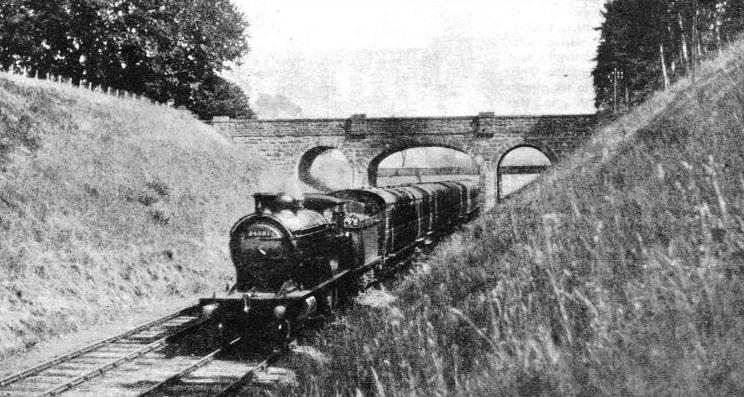
IN THE FAR NORTH. A through Glasgow to Inverness train in one of the picturesque cuttings on the LMS Highland Section near Millburn Junction, Inverness. The locomotive, No. 14381, “Loch Ericht”, is one of the former Highland Railway outside-
The Midland grew in importance, but remained for a time only a provincial undertaking, the London terminus at St. Pancras not being opened until October, 1868, although previously Midland trains had reached London over the Great Northern tracks. After the company had come into possession of its own terminus it adopted a progressive policy, largely due to the enterprise of the late Sir James Allport, one of the most celebrated of all English railway managers.
On April 1, 1872, Allport created a sensation in the railway world by announcing that thenceforth the Midland would carry third-
That the Midland was the first to admit third-
The First Excursion Train
This railway was the Sheffield and Rotherham, which was opened in 1838, and was the first to do away with the intermediate class. But, while under the Allport regime the third-
But although the Midland grew out of Hudson’s amalgamations, the first portion of the system constructed was the Leicester and Swannington Railway, which, as happened with so many of the early lines, was built with the primary idea of cheapening the conveyance of coal. It was opened in July, 1832, and one of its original features was a “self-
The generally accepted story is that one of its engines, the “Samson”, ran over at a level crossing a cart laden with eggs and butter, and that to avoid a repetition of such accidents, it was suggested to George Stephenson by the manager of the line, who afterwards became the first general manager of the London and Birmingham Railway, that it might be possible to equip the locomotives with a steam-
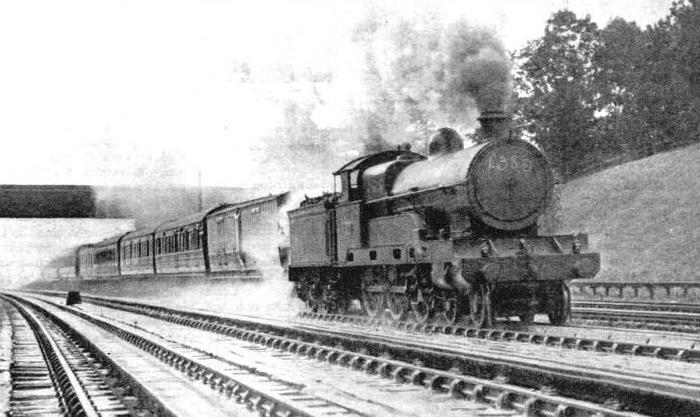
TAKING UP WATER from Bushey troughs, nearly sixteen miles from Euston, on the main line of the Western Division. The former London and North Western Railway was the first to introduce -
The first excursion train was run on July 20, 1840, and was organised by the Nottingham Mechanics’ Institute, whose members desired to visit an exhibition at Leicester. When the railway company received a list of intending passengers, it arranged to run a special train at half fares, and a week later the Leicester Mechanics’ Institute was granted similar facilities for a visit to an exhibition at Nottingham. These two trains were so successful that in the following month the railway company ran excursions of its own, one from Leicester and intermediate stations to Nottingham, and the other in the reverse direction. No fewer than 2,400 people booked for the latter; they were accommodated in a single train composed of sixty-
Out of these beginnings there grew the travel business of Thomas Cook (which also originated in an excursion on the Midland) and the whole vast traffic at cheap rates, which in Great Britain today makes up more than half of the main line passenger bookings.
When the Midland Railway Company was formed in 1844, it became the largest single undertaking in the country, if not in the world, in point of mileage. Its tracks, then 181½ miles long, were partly laid on stone blocks and partly on longitudinal sleepers, with a section a mile and a half long laid on bridge rails. Considerable savings were the immediate result of fusion. For instance, the three separate locomotive “shops” at Derby were merged into one, and were placed under the supervision of the celebrated Matthew Kirtley, who remained in charge until his death in 1873, when he was succeeded by S. W. Johnson.
Both engineers left their mark on Midland locomotive design. Kirtley was a pioneer of standardisation; when he took over control he found a stud of ninety-
The absorption in 1846 of the Bristol and Gloucester Railway enabled the Midland to reach Bristol, the terminus at Temple Meads adjoining that of the Great Western. Because of certain legal engagements, the Bristol and Gloucester Railway was for a time obliged to remain a broad-
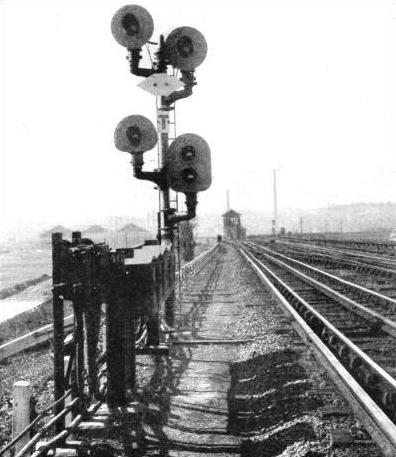
UP-
Two years before the Midland was able to work through on the narrow gauge to Bristol, a proposal had been put forward for amalgamation with the London and North Western. The latter company was agreeable, and the Midland was eager, since its constantly growing traffic was every year rendering direct access to London a question of greater urgency. But the scheme fell through, as the North Western, “thinking the bargain safe”, insisted on knocking fifty shillings a share off the minimum price that had been fixed by the Midland chairman. Later in the same year the Midland company was approached by both the North Western and the Great Northern with a view to amalgamation, and the matter went so far as the promotion of a Bill in 1853 for the fusion of all three companies. Had this plan materialised, the result would not only have been the creation of the greatest single railway system under one ownership then in existence in any country, but might also have profoundly influenced British railway practice as a whole. Parliament considered that the national interest would be best served by the existence of as many competing railways as possible, and threw out the measure.
Had the scheme succeeded, it would have saved much competition that while it gave certain benefits to the public, inflicted considerable losses on the stockholders. It has been said that the Great Northern (now part of the London and North Eastern Railway) was “pre-
Before leaving the Midland, we may recall two more historic facts of its career. It was the first railway to carry coal to London. In 1845 coal was conveyed from Clay Cross to Rugby, whence it was transferred to the London and Birmingham Railway, to the great disgust of the autocratic general manager of that system, who complained that his line would next be called on to carry manure. The traffic was accepted, but “it is on record that when coal trucks first passed over this line they were ‘sheeted’ down so that their contents might not be suspected; and at Weedon, where coal was transferred to the railway from the barges of the Grand Junction Canal, there stood for many years a high screen, erected originally to conceal the ignominious transaction from the eyes of the passing traveller”. Today, coal and coke tonnage represent a far greater volume of traffic on the British railways than all other merchandise put together, and in 1934 the LMS alone carried over seventy-

THE LATEST LMS steel-
The germ of the Lancashire and Yorkshire Railway was the Manchester-
The Lancashire and Yorkshire was a pioneer in electric traction, which was first introduced on the Liverpool-
The Furness and North Staffordshire Railway, both ranking as constituent companies, were much smaller concerns. The former originated in a line in the Barrow district that was mainly intended for the conveyance of minerals. It has been described as “a local line unconnected with the main railway system”. This undertaking was incorporated in 1844. Subsequently the company absorbed the Ulverston and Lancaster, Coniston, and Whitehaven and Furness Junction Railway, took over the working of the Cleator and Workington Junction, and was the joint owner with the Midland and North Western of other lines. At grouping, it owned 115 miles of route, in addition to its share of twenty-
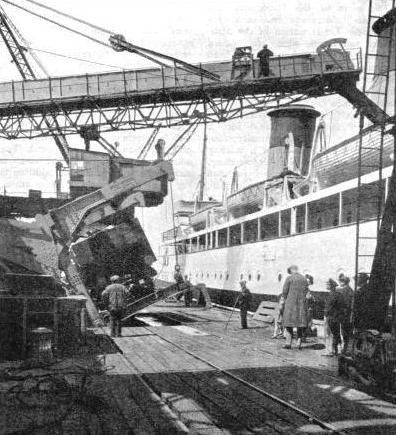
COALING SHIP at Heysham, Lancashire. One of the LMS express steamers is being prepared for the trip across the Irish Sea to Belfast. The “Ulster Express”, leaving Euston every week-
The North Staffordshire, which served the “Five Towns”, was the larger and more important of the two minor constituent companies. Its northern extremity was Macclesfield, and by the exercise of running powers its trains ran also into Nottingham, Derby, Burton-
Mention must also be made of an undertaking that, although small in point of mileage, formed an important link in the British railway system. This was the North London Railway, which was incorporated in 1846 for the purpose of linking up the London Docks by a line from the North Western’s Camden Town goods station. A close working arrangement always existed between the two railway companies, and the North London head offices were at Euston Station, where its stockholders’ meetings also used to be held. At the end of 1908 an agreement was entered into under which the North London was thenceforth worked under the supervision of London and North Western officers, but the railway remained a separate undertaking until 1923.
The original grouping scheme provided for five and not four amalgamated companies, the intention having been to set up a separate group for Scotland. But the Scottish companies objected on the ground that the small population of the country and the relative lack of industrial development would impose a financial handicap on such a group, and that they therefore preferred to be associated with the English companies. The scheme was amended accordingly, the general basis being that the lines forming the Scottish section of the West Coast route became part of the LMS, while those on the East Coast went to the LNER.
Including joint lines and small subsidiaries, the total route length of the Scottish lines taken over by the LMS was approximately 2,200 miles. The largest system was that of the Caledonian Railway, with a route mileage of 896. It had the longest main line of all the Scottish companies, extending from Carlisle to Perth and Aberdeen, via Coatbridge, with offshoots to Edinburgh and Glasgow. Together with the London and North Western Railway, it formed the West Coast Route between England and Scotland.
Scottish Railway Rivalry
The undertaking out of which this railway developed was incorporated in 1845, for the construction of a railway from Carlisle to Edinburgh and Glasgow, and the company did not obtain its Act of Parliament until after a fierce and lengthy struggle, which cost £70,000. Once powers had been obtained, the work proceeded so rapidly that the first sod was cut on October 11 of the same year, the initial section from Carlisle to Beattock was opened in September, 1847, and trains were running through to Edinburgh and Glasgow in the following February.
The early history of the Caledonian was not peaceful. “Under powers of various Acts, this company, at a time of great excitement and much uncertainty as regards the real profits made out of railway undertakings, became involved in engagements which were found to be beyond its resources”, and a financial rearrangement, which was carried out in 1851, consequently became necessary. When the company obtained its first Act there was a general belief that traffic possibilities would never warrant the construction of more than one trunk line between England and Scotland, and the railway history of the period is coloured by the fight between the advocates of the West Coast and East Coast routes.
The Glasgow and South Western Railway was a more compact undertaking. It began at Gretna Junction, whence its trains ran the eight and a half miles to Carlisle over the Caledonian tracks, and the main line extended to Glasgow, via Dumfries and Kilmarnock. Another line ran along the west coast of Scotland, serving Ayr and Ardrossan, and connecting with the Portpatrick and Wigtownshire Railway, an east to west line in which the company had a joint share with no fewer than three other systems -
THE SUSPENSION BRIDGE at Crewe connects the railway station with the locomotive works. Crewe, in Cheshire, 158 miles from Euston, is the most important railway junction on the Western Division of the LMS. Here the Euston-
Carlisle formed the southern terminus of both the Caledonian and Glasgow and South Western systems. Before 1923 the station was managed by the Carlisle Citadel Station Joint Committee, which had the status of a joint railway company, and it was jointly owned by the Caledonian and the London and North Western. Five other railways -
The Highland Railway, as its name implied, was an undertaking entirely confined to the north of Scotland, over which its line spread in the shape of a cross. The southern terminus was at Stanley Junction, near Perth, where it linked up with the Caledonian. It extended northwards to Wick and Thurso, and the centre of the system was Inverness, through which passed the lines to the east and west coasts. It began with the fifteen-
Turbine-
Traffic between the East and West Coast routes has always been highly competitive. The two “races to Scotland”, in 1888 and 1895 respectively, are dealt with in the chapter Locomotive Speed Records, which begins on page 529.
Track troughs, which enable locomotives to take up water, were first laid in 1860. They were the invention of John Ramsbottom, a famous locomotive superintendent of the London and North Western Railway. Their use has permitted the introduction of the long non-
Of the locomotive works, Crewe has been described as “probably the largest and most celebrated railway establishment in the world”. It opened its doors in 1843, when it was owned by the Grand Junction Railway, and has an area of some 160 acres, of which over fifty are covered, In recent years it has undergone extensive modernisation.
Second in point of importance on the LMS are the Midland “shops” at Derby, which make carriages and wagons, as well as locomotives, and cover about 210 acres. The carriage “shops” on the Western Division are at Wolverton, Bucks.
Famous engines of the nineteenth century, beginning with Stephenson’s “Rocket”, include the “Bloomers”, “Precedents”, and Webb compounds of the London and North Western, the Midland bogie singles and the Caledonian 4-
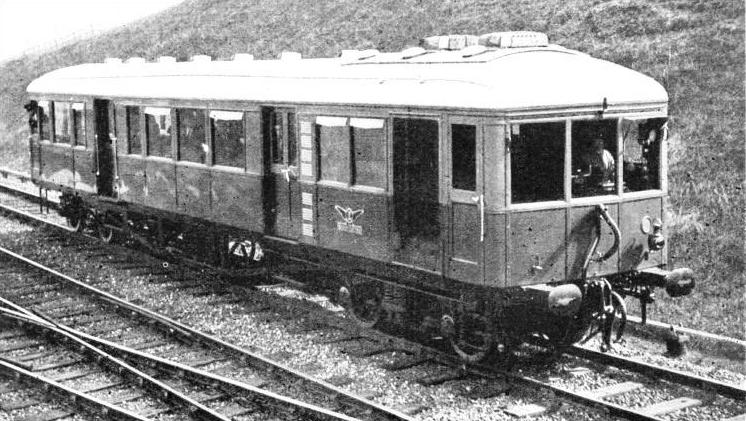
NEW TRANSPORT IDEAS are constantly receiving attention on the LMS. Here is a Diesel-
You can read more on “Britain’s Inland System”, “On the Footplate of an Express”, “The Royal Scot Route”, “The West Coast Postal” and “The World’s Most Famous Railway” on this website.
